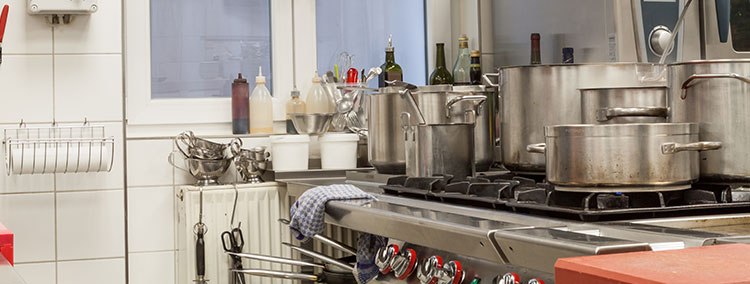It’s recommended that you hire an appliance repair professional to service your appliance, as it gives you peace of mind that they are doing the right job and will leave your appliance in tip-top shape.
While this is the case, sometimes you don’t have the money to hire the service provider. In other cases, you don’t have time to wait for the service provider to arrive and need to service the unit.
In such an instance, you don’t have any other way out than to service the appliance yourself. To help you out, here is how to go about it.
Remove the filters, spray arms and racks.
Because the filters and spray arms are likely clogged, you should soak them with the racks in a mixture of warm water and distilled vinegar for at least one hour. Of course, you can soak them for longer if you want to and have time for it.
After soaking them, wash them with a brush to ensure nothing is left behind. You can use a toothpick to clean the tiny pores in the spray arm and filter. This takes time, but it makes all the difference. Once you are done, use hot water to rinse them inside and out.
Filters and spray arms typically clip off, but if you don’t know how to remove yours, examine the handbook. Look for dirt, food particles, or mineral deposits in the filters. Scrub away the accumulated debris with a soft-bristled brush, such as an old toothbrush. To remove any leftover residue, rinse the filters with warm water.
Put your toothbrush to work.
Using a toothbrush takes time, but it is well worth it. You should use an old toothbrush and dip it in equal parts baking soda and vinegar before going over all the nooks inside to ensure no food particles remain.
Cleaning with vinegar and baking soda produces a strong solution that dissolves dirt fast.
Using the toothbrush, you should clean the gasket and door edges. Regularly clean the rubber gasket surrounding the dishwasher door and edges to avoid mold and debris buildup.
You should scrub the gasket gently with the toothbrush to remove any debris or residue, then once you are done, rinse it.
Remove debris or obstructions from the dishwasher drain using a small brush or toothbrush. To avoid water backup or drainage concerns, clear the drain.
Run a cleaning cycle.
Some dishwashers have a cleaning cycle. According to the manufacturer’s directions, you should run a cleaning cycle using a dishwasher cleaner or a vinegar and baking soda mixture. This cycle helps remove built-up residue and keeps the dishwasher clean.
When the cleaning cycle is complete, and the dishwasher has cooled, open the door and inspect the interior. Wipe any residual residue or buildup inside the dishwasher using a gentle cloth or sponge. Pay close attention to the corners, fissures, and door edges and ensure they are pristine.
Rinse the appliance with vinegar.
To ensure the dishwasher is completely disinfected and all particles have been thoroughly removed, rinse it with vinegar.
You need to replace the filters, spray arm, and racks, then place a dishwasher-safe bowl of white vinegar at the bottom and run it on the hottest and longest cycle.
You should always use white vinegar for this. The reason is that white vinegar has low acidity, so that it won’t ruin your appliance. Avoid other vinegars, such as apple cider vinegar, as they might cause some harm.
The vinegar will dissolve any remaining food particles you may have missed when cleaning your appliance. This practice works like magic when it comes to descaling the dishwasher.
While vinegar is an efficient descaling agent, you should avoid using it on all dishwasher components. Use vinegar sparingly on any rubber or sensitive parts, such as the gasket or seals, as it may cause harm. You can see specific directions and recommendations in the dishwasher’s owner’s manual.
If you have highly tenacious limescale or mineral deposits or reside in a hard water location, you may need to repeat the vinegar descaling process or consider using a commercial dishwasher descaler as directed by the manufacturer.
Deodorize the appliance with baking soda.
Although the preceding step may have cleaned the appliance sufficiently, you can go further and sprinkle a cup of baking soda at the bottom of the dishwasher before running it on the longest and hottest cycle. This eliminates any remaining stains and deodorizes the machine.
How you go about it is that you close the dishwasher door after pouring the baking soda and leave it there for hours or overnight. Baking soda will absorb the scents as a result of this.
After the baking soda has had time to sit, wipe off the interior, including the door, walls, and racks, using a damp cloth or sponge. This aids in the removal of any residual baking soda and absorbed odors.
Finally, run a rinse cycle in the dishwasher without any dishes or detergent to guarantee that all baking soda residue is gone. This will assist in draining out any leftover baking soda, leaving your dishwasher clean and odor-free.
Using baking soda regularly can help prevent odors from accumulating in your dishwasher. If you continue to smell strong or persistent scents, it could be a symptom of a larger problem, such as a clogged drain or a problem with the dishwasher’s plumbing.
In such instances, reviewing the manufacturer’s manual or seeking assistance from a professional dishwasher repair Springfield technician is essential.
When seeking the services of a technician, ensure that they are experienced and know what they are doing. You don’t want someone that ends up causing more problems than were originally there.
Finish the job
Once you are done, you should return everything where it was before, and if the outside of the appliance is dirty, get rid of the dirt using a clean piece of cloth.
